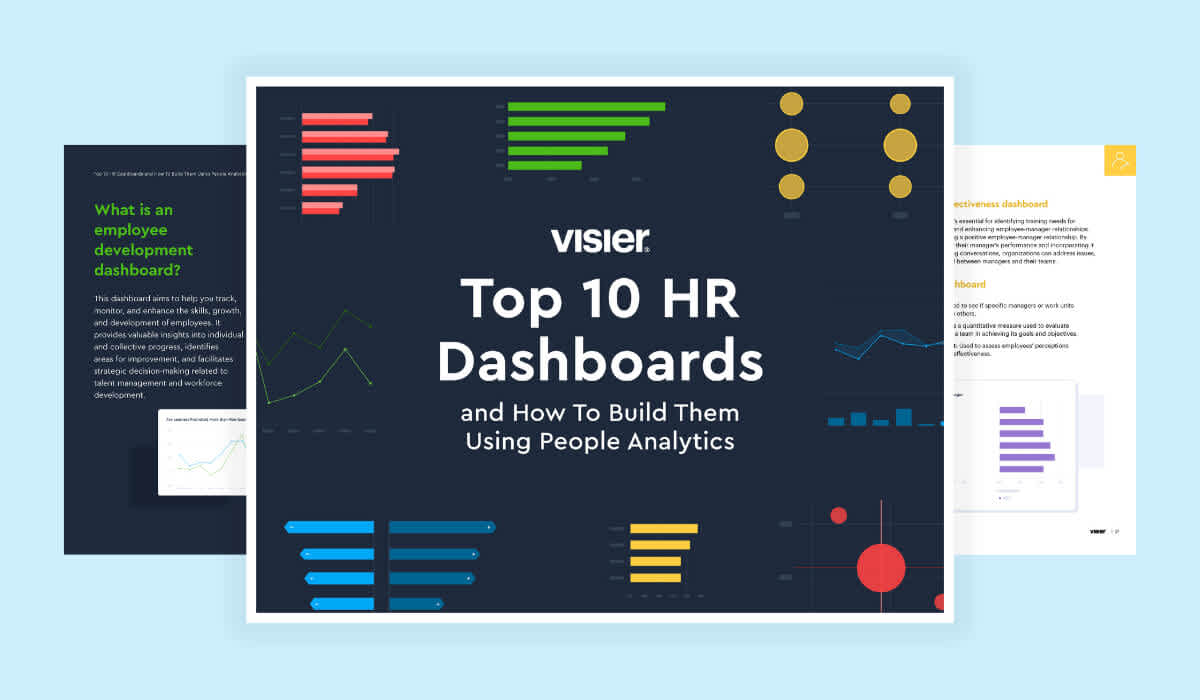HR Analytics and Reporting: Driving Evidence-Based Decisions
Effective use of HR analytics and reporting within an organization helps to drive evidence-based and objective decision-making. Learn more here.

Ask companies what their goals are when it comes to their employees, and they’ll start talking about productivity, performance, talent acquisition, time to hire, and more. They might tell you about the HR metrics they’re observing and the tactics that help them get closer to their goals. HR analytics and reporting is the process that brings all of these things together.
From collecting, observing, analyzing, and presenting your findings, HR analytics and reporting offers a clear view of your people data helping you make the right decisions at the right time.
What is HR analytics and reporting?
HR analytics and reporting are similar concepts, with many using them interchangeably. They are far from being two peas in a pod, though. They complement each other and you’ll see the best results when using them together.
HR analytics
HR analytics is the process of identifying, collecting, and analyzing people data. Also referred to as people analytics, this process turns data into actionable insights that can shift the way you approach business, drive objective and informed decision-making, and help you reach your goals.
When talking about analytics, many only see the analysis part. This misses a significant and critical portion of the process. Here’s an example.
Let’s assume you’re experiencing high turnover rates. You want to understand why this is happening and reduce attrition. To do this, you will need to start by collecting relevant data. This can include things like compensation, bonuses and merit increases, learning and development programs, and more.
You need to first collect the right data to get good results from your analysis. Too little information will lead to incomplete or incorrect results. Too much data will make your work harder than it needs to be.
Once you have the metrics and data at hand, you can begin the analysis process, using the useful KPIs to gain insights. You will look for patterns that can help you understand why some employees choose to leave while others stay.

HR reporting
HR reporting is the systems, processes, and deliverables that businesses use to consolidate and present various data points into a single report. This dictates how metrics and data are organized and presented. HR reporting offers teams a simple, yet effective way to present their findings to the management and stakeholders.
A report is the logical follow-up to HR analytics. You first collect and analyze the data. Perhaps you make decisions based on your observations. In the end, you need to review and present your findings.
HR analytics may be harder to understand for those who don’t work with that type of data every day. The HR report bridges this gap and gives the HR team an easy way to present their findings to the entire company. Because it usually comes in a compact form, it is also easy to distribute to leaders of various departments.
Let’s look back at the previous example. The company used analytics to find out why the turnover rates were increasing and how to stop this trend. The HR team must now present their findings to stakeholders, which is where an HR report will come in.
The report can include raw data, statistics, and charts to make it easier for everyone to understand the issues at hand. It can also contain recommendations and other insights based on HR analytics findings.
An HR report can be useful once the company takes measures to lower attrition. Together with HR analytics, it will provide a simple way to see which tactics are working best and which aren’t making any difference.
You don’t need to create reports in the same rhythm you use analytics, though. In fact, analytics will usually be a continuous process, whereas reporting is used periodically. That’s why reports are great tools to view progress and assess business decisions—they don’t look at immediate data, but instead take a broader approach that allows you to see patterns and changes.
What are HR reports used for?
Monitoring HR metrics and reporting on the workforce is one of HR’s essential tasks. When used properly, reporting can be beneficial for businesses, providing three key functions.
1. HR monitoring
Tracking metrics is one of the best ways to stay on top of the many issues that can take place in an organization. HR reporting allows you to do this efficiently. It helps you spot trends and opportunities so you can take advantage of them and use them to reach your goals faster.
HR dashboards, for instance, which are often part of HR reporting, help review and improve various processes. Plus, an HR report can show you potential issues before they cause problems.
2. Improved management
HR reports are the perfect tool when you want to inform managers in the company about various data related to the workforce. They’re easy to share and present the information in a clear, concise manner that is quick to digest even by the busiest people in the company.
On top of helping them become better managers, HR reports can also help improve the decision-making process. People in leadership positions will be able to make data-informed decisions and track the results with little effort.
3. Track areas of risk
No matter how well you plan everything, risks and problem areas are inevitable in a business. That’s why analytics and reporting in HR are crucial. On the one hand, they might help you spot potential risks before they happen. And even if an issue occurred, they will help you track what’s happening and take measures to solve it.
Plus, HR analytics and reporting are great tools for increasing transparency. Let’s look back at the previous example, the company experiencing high turnover rates. When you collect and analyze data, you may notice that turnover rates are higher in one department, for instance.
These numbers will appear in the report, increasing transparency and encouraging managers to pay more attention to the issue in the future.
Tracking problem areas is the best way to go if you want to drive real change and find solutions that actually work.
3 ways to use analytics reporting
Analytics and reporting in HR should be the go-to tools for any company that wants to improve its decision-making process, track areas of risk, improve transparency, and view the impact that each critical decision makes on the workforce.
How you use them could depend on your goals. If you’re simply looking to uncover the cause of an issue like high turnover rates, you’ll most likely be focused on that one area. But if your approach is more general and proactive, a broader perspective will be the way to go. Here are some ways to use analytics reporting.
1. Identify workforce trends
When you use HR analytics and reporting, you’re observing key metrics and data that will help you identify workforce trends. This will, in turn, help you improve the decision-making process incrementally.
Let’s say you’d like to understand turnover patterns. There is no pressing emergency, no one department where people are quitting at an alarming rate. What you want is to find out if there are any patterns regarding attrition.
You will collect data related to your workforce that could help shed light on the matter. This includes things like turnover rates for each department or manager, demographics, compensation, productivity, and more.
Analytics will then assist you in taking a more in-depth look at that data and finding patterns. Through reporting, you can assess your findings, discuss them with stakeholders, and decide how to address any negative trends.
2. Optimize the talent acquisition strategy
Talent acquisition is a crucial area for any company and HR team. Creating a recruitment program that works is not always as straightforward as you’d imagine. Sometimes you create a job ad only to have very few applicants or people who are not a good fit. Other times, your acceptance rates aren’t the best, or the time-to-productivity is extremely long.
Analytics and reporting provide an easy way to address these challenges. For instance, they can help you understand why the time-to-hire is longer than you’d want or why acceptance rates are low.
You can track and analyze things like the number of applicants per job posting, the number of applicants who make it through the first interview phase, and more. Based on this analysis, you can make changes to the various phases of the application process to achieve better results.
Later, through reporting, you can also see how the changes you made impact the strategy. Are more people applying now? Did the time-to-hire and the time-to-productivity decrease?
The process will show you any red flags and areas where you can improve your recruitment program.

3. Monitor compliance risks
Compliance risks are a reality for most businesses and monitoring them is a must. By observing and analyzing metrics related to hours worked, compensation, absenteeism, and more, you can identify liabilities and ensure compliance with local regulations.
Let’s say, for example, you want to ensure you’re compliant with labor laws regarding compensation and benefits. You begin by collecting and analyzing data about employee pay for each role, bonuses, and other benefits, as well as things like overtime and paid time off.
Through your analysis, you notice there are some employees doing a lot of overtime without being properly compensated.
A thorough report will allow you and managers to find customized solutions to avoid legal issues and improve employee satisfaction. You’ll also be able to keep an eye on the issue in the future to avoid running into the same type of problem again.
The bottom line
HR analytics and reporting are tools that work best when used together. HR analytics, sometimes referred to as people analytics, helps you turn valuable data into strategic insights that will guide you to making better business decisions.
HR reporting puts those findings in an easy-to-read format you can present and share with stakeholders, managers, and other people in the company. It’s a must-have if you want to monitor risk areas and follow your progress. Used together, they’ll assist you in having a better, more effective, and more engaged workforce and reaching your business goals.
On the Outsmart blog, we write about workforce-related topics like what makes a good manager, how to reduce employee turnover, and reskilling employees. We also report on trending topics like ESG and EU CSRD requirements and preparing for a recession, and advise on HR best practices like how to create a strategic compensation strategy, metrics every CHRO should track, and connecting people data to business data. But if you really want to know the bread and butter of Visier, read our post about the benefits of people analytics.



